(Updated at 4:45 p.m.) Local elected officials, including Rep. Gerry Connolly, gathered in Lorton on Wednesday to celebrate the introduction of 42 new electric buses to the division’s fleet.
These buses, which were funded by a $16.5 million federal grant announced in January, join the 18 electric buses already in operation. Although the division currently operates over 1,600 diesel buses, county officials emphasized that these new electric buses mark the start of a larger transition.
“I know that this downpayment is the beginning of something much larger, and that’s going to take many years for us to complete,” School Board Chair Karl Frisch told the crowd of attendees at Lorton Station Elementary School on Wednesday.
“But I’m confident with our continued activism by our students, their parents, our Moms Clean Air Force and our school board colleagues and our friends at the state and federal level that we can get there because we absolutely have to,” he continued.
FCPS has pledged to provide entirely carbon-neutral student transportation by 2035. So far, the division has reduced 38% of its greenhouse gas emissions from 2008, according to the 2022 FCPS Greenhouse Gas Inventory Report.
In January 2021, the division received its first electric school bus as part of a Dominion Energy-led initiative aiming to replace all diesel school buses in Virginia by 2030. However, the Virginia House of Delegates rejected the expansion of this program, opting instead to create a grant fund.
In March, VDOT announced it had allocated $11.3 million in federal funding to assist the statewide construction of electric vehicle charging stations.
FCPS received eight electric buses from Dominion in 2021 and secured a state grant for 10 additional buses through a settlement with Volkswagen, which had been sued for emissions test cheating in 2016.
The new federal grant funds come from the Bipartisan Infrastructure Law, signed by President Joe Biden in 2021. The grant, administered through the EPA’s Clean School Bus Program, allocates $5 billion to the Clean School Bus program which is dedicated to replacing existing school buses with zero-emission and low-emission models.
“Every day throughout the United States we’re transporting 10s of millions of students on buses, and many of those buses are anything but clean,” Connolly said during the event.
“Here in Fairfax we’ve got 1,600 school buses, and today’s a great down payment toward a movement for replacing every one of them and making sure our kids are safe and in a healthy environment but also in a vehicle that is not contributing to the environmental problem,” he added.
Reston Town Center’s first solar panels are on the horizon.
Boston Properties (BXP) plans to install solar panels on top of the green garage in the town center, the property owner and developer announced Friday (March 15). The installation will feature a 1.3-megawatt solar photovoltaic renewable energy system.
“With great partners like our client and Ameresco we can transform a parking garage into a megawatt scale solar energy plant,” BXP Senior Vice President of Sustainability Ben Myers said. “This project delivers social, economic, and environmental benefits over a long term by providing zero emissions clean power, competitive energy pricing, and covered parking for clients and visitors at the Town Center.”
The project is in partnership with Ameresco, an energy developer. It’s expected to provide an estimated 1.5 million kilowatt-hours of renewable energy annually. Energy from the system will be used at Reston Town Center.
“We are thrilled to partner with BXP and their client on this exciting solar canopy project in Reston, Virgina,” Ameresco Senior Vice President Jonathan Mancini said. “By joining forces, we are building a solar solution that will empower the entire Reston community with greater energy independence and reduced reliance on the grid. This collaborative effort is a shining example of how working together can create a more resilient future for all.”
The project is expected to wrap up construction by the end of the year.
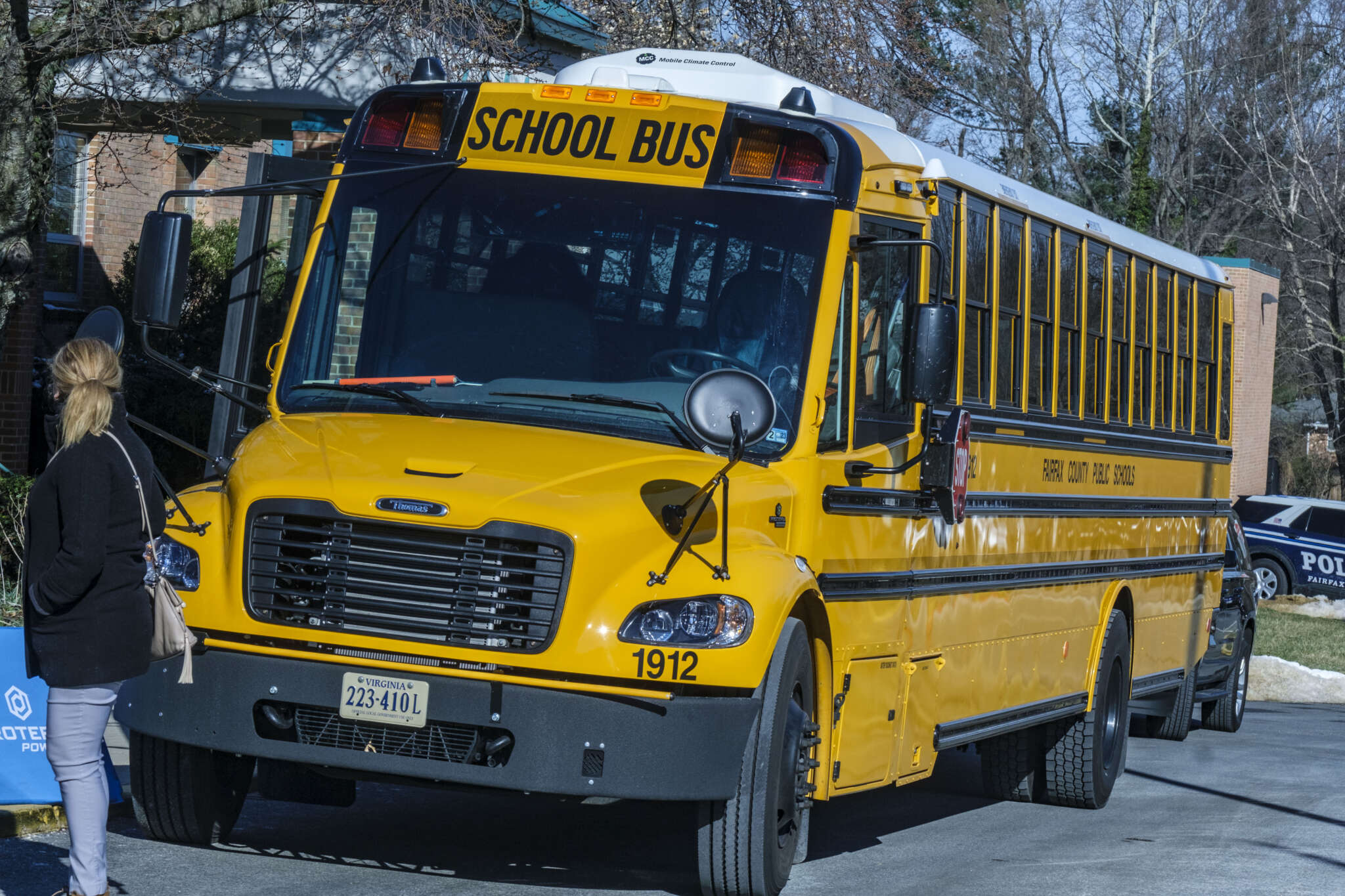
Fairfax County Public Schools will more than double the number of electric buses in its fleet, thanks to a new federal grant.
The local school system has been awarded $16.59 million as a winner of the U.S. Environmental Protection Agency’s inaugural Clean School Bus program grants competition. The other winner announced yesterday (Monday) was also from Virginia: Newport News Public Schools will receive $525,000.
The funds will enable FCPS to purchase 42 electric school buses. According to its website, the district currently has eight electric buses in a fleet with 1,625 buses, but it was slated to add another 10 in 2022. FCPS didn’t respond by press time when asked to confirm whether those buses are now operating.
“We are honored and excited to be among the recipients of the Environmental Protection Agency’s Clean School Bus Awards,” FCPS Superintendent Dr. Michelle Reid said in a statement. “This recognition not only underscores our commitment to sustainability and environmental stewardship but also reflects our ongoing efforts to provide healthier, cleaner transportation for all Fairfax County Public Schools students.”
FCPS has pledged to provide entirely carbon-neutral student transportation by 2035. The first electric school bus arrived in January 2021 as part of a statewide initiative led by Dominion Energy, which had proposed replacing all diesel school buses in Virginia by 2030.
However, the Virginia House of Delegates voted against expanding Dominion Energy’s program that spring, instead creating a grant fund that never got funding.
After getting eight electric buses from Dominion in 2021, FCPS received a state grant for 10 buses out of a settlement agreement with Volkswagen, which had been sued in 2016 for cheating on vehicle emissions tests.
The new federal grant funds come from the Bipartisan Infrastructure Law signed by President Joe Biden in 2021, allocating $5 billion to create the Clean School Bus program, which is dedicated to replacing existing school buses with “zero-emission and low-emission models.”
While FCPS intends to buy electric buses, Newport News requested funding to add propane-fueled buses, a switch it said will reduce emissions and lower fuel and maintenance costs.
Rep. Gerry Connolly called the grant “a game-changer” for FCPS.
“The environmental benefits of these new buses are vitally important to our fight against climate change, but the good news doesn’t stop there,” Connolly said. “Students, staff, and parents who spend time on and around school buses will no longer be exposed to diesel exhaust and other toxins from diesel-powered buses.”
This is a gamechanger for Fairfax County. Clean school buses will bolster our fight against climate change and protect the health of students, staff, and parents.⁰
This win comes thanks to the #BipartisanInfrastructureLaw signed by President Biden.⁰https://t.co/mcAKAvZZoH https://t.co/an33Aarx5K— Rep. Gerry Connolly (@GerryConnolly) January 8, 2024
Outside of the school system, the Fairfax County government adopted an operational energy strategy in 2021 whose targets included converting all of its buses and fleet vehicles to electricity or another non-carbon-emitting fuel by 2035.
Fairfax Connector, the county’s public bus system, welcomed its first electric buses in September, and the Department of Public Works and Environmental Services added an electric trash truck in August.
Late last year, the county launched a Climate Action Dashboard to keep track of its progress on various efforts to combat climate change. The transportation portion of the dashboard indicates that the county government has acquired 224 hybrid and 50 fully electric vehicles, putting it just 1.5% of the way to its goal of completely transitioning in just over a decade.
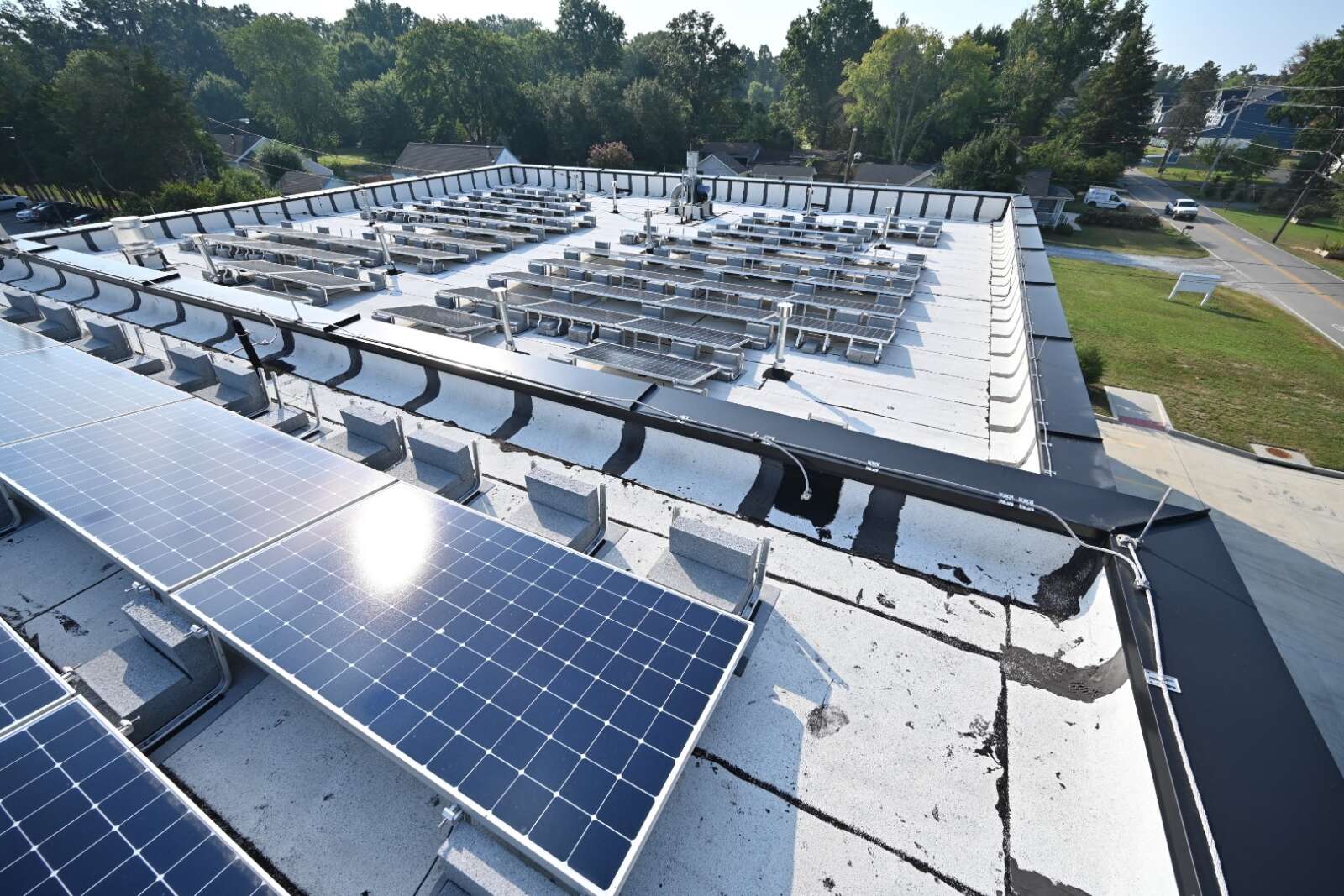
The public can get a closer look at Fairfax County’s efforts to combat climate change with an updated Climate Action Dashboard.
The dashboard updates, released yesterday (Dec. 18) by the Fairfax County Office of Environmental and Energy Coordination (OEEC), include a new interactive map and sector-specific landing pages, so community members interested in buildings, for example, can view those metrics separately ones about waste.
Overall, the updated dashboard aims to highlight how data informs county decision-making and how positive results come to be through “collective effort,” per a county press release.
So far, progress includes a 30% reduction in greenhouse gas emissions between 2005 and 2020 and an increase in solar installations.
The county has an extensive set of climate-related goals, outlined in three plans. Two of those plans — the Community-wide Energy and Climate Action Plan and the Operational Energy Strategy — focus on emissions, while the third focuses on climate resilience against natural disasters like flooding and heat.
“Resilience means being able to bounce back fully from shocks and stressors that come our way without suffering permanent loss,” OEEC acting director John Morrill told the Board of Supervisors at an environmental committee meeting last Tuesday (Dec. 12).
The county is making progress on a variety of its environmental goals, according to a high-level summary Morrill presented at the meeting.
For example, it’s ahead of where it needs to be to retrofit at least 100,000 housing units with energy efficiency by 2030, and it has surpassed a goal of increasing telework and non-motorized commuting, though the OEEC acknowledges that could “regress” as more workers return to offices after the pandemic.
In other metrics, however, the county is behind its benchmarks. Just 10% of energy in the community comes from clean sources, when it should be at 20% to reach its goal of all clean energy by 2045, and 48% of waste is being diverted from landfills or incineration, a rate that should be closer to 60% to reach 90% by 2040.
Morrill noted that the county has more control when it comes to developing resilience than when reducing emissions.
“Emissions reduction is a national and global effort, and much is beyond our control or even influence,” Morrill said. “We’ll be more clearly defining the factors beyond county control to better calibrate our efforts and expectations to ensure that we are focused on making the most of what the county can do best.”
Morrill compared climate resilience to running on a treadmill as its speed increases, and said it may not be possible to reach 100% resilience.
“Nevertheless, the county’s resilience efforts are crucial to ensuring we do not fall off the back of the treadmill, which in this metaphor would mean permanent loss of life, property and resources,” Morrill said.
At the meeting, Board of Supervisors Chairman Jeff McKay said community engagement would be key to achieving the county’s climate action goals, including its target date of 2050 for achieving carbon neutrality.
“Without their engagement and involvement, we can’t achieve these overall goals,” McKay said.
An addendum to Morrill’s presentation provided updates on several county initiatives. For example, Charge Up Fairfax — a pilot program that assists residential communities with electric vehicle charging — launched with five neighborhoods this year. Another five neighborhoods were recently added.
Fairfax County’s cooling centers, which got revamped earlier this year, had 251 visits in 2023.
The OEEC will regularly add new and more up-to-date information to its Climate Action Dashboard, according to the press release. The board will receive more detailed information about the county’s progress on its goals early in the new year, Morrill said.

Virginia is beginning to create plans for how to reduce greenhouse gas emissions, the primary driver of climate change, on a state and regional basis thanks to millions of dollars from the federal government.
This June, the U.S. Environmental Protection Agency awarded about $6 million in grants to Virginia’s Department of Environmental Quality, regional planning organizations in Northern Virginia, Richmond and Hampton Roads and the Monacan Indian Nation to create two plans.
One, the Priority Climate Action Plan, will identify projects that can immediately start reducing greenhouse gas emissions. The other, the Comprehensive Climate Action Plan, aims to craft long-term strategies to achieve reductions.
“This grant will help us plan for reducing climate pollution and promoting climate resilience in the commonwealth, both of which are central to our mission,” said DEQ Director Mike Rolband at a webinar last week. “Just as changing climatic conditions impact all of Virginia, these changes also impact all of the environmental programs here at DEQ. “
The funding for the Climate Pollution Reduction Grants program comes from the Inflation Reduction Act, major federal legislation passed last year that aims to spur investments in climate technologies.
The priority plan is due in March 2024. Projects included in the plan will be eligible to compete for an additional $4.6 billion round of grants for implementation.
The comprehensive plan is due later, in July 2025, and will involve broader strategies for reducing emissions from the transportation, electricity and other sectors, as well as an analysis of the benefits of greenhouse gas reductions.
Both plans require that officials consider the benefits of reductions for low-income and disadvantaged communities and monitor emissions.
Statewide plan
Virginia’s Department of Environmental Quality will be the lead agency coordinating the state’s planning process, which will include the Virginia Department of Transportation, Department of Housing and Community Development, Department of Conservation and Recreation and other agencies.
Virginia has already taken a number of significant steps to reduce greenhouse gas emissions, many of which DEQ cited in its application to the EPA.
The 2020 Virginia Clean Economy Act seeks to decarbonize the state’s electric grid by 2050 by setting renewables development targets for regulated utilities and mandating that increasing portions of their generation be carbon-free. In 2021, Virginia also tied its vehicle emissions standards to California’s rather than remaining on the federal standard in an effort to drive greater adoption of electric vehicles, and the state is planning to use National Electric Vehicle Infrastructure program funds for charging infrastructure buildouts.
Additionally, Virginia since 2021 has participated in the regional carbon market known as the Regional Greenhouse Gas Initiative, or RGGI. That program requires electricity producers to pay for allowances for each ton of carbon they emit and returns the revenues to the state for energy efficiency and flood preparedness programs. Read More

Several environmental groups, including one based in Fairfax County, have joined forces to challenge Gov. Glenn Youngkin’s decision to pull Virginia out of a cross-state initiative aimed at reducing carbon emissions.
The Southern Environmental Law Center announced on Monday (July 31) that it will appeal Virginia’s planned withdrawal from the Regional Greenhouse Gas Initiative (RGGI), a market of 12 states on the East Coast that regulates carbon emissions from power generators.
The appeal will be filed in Fairfax County Circuit Court on behalf of Appalachian Voices, the Association of Energy Conservation Professionals, Virginia Interfaith Power and Light and the Faith Alliance for Climate Solutions (FACS), a Fairfax County-focused coalition of religious communities pushing for action to address climate change.
The notice of appeal was served on the same day that the proposal to drop out of the RGGI was published in the Virginia Register, opening a period of public comments until the regulation takes effect on Aug. 30.
“The Regional Greenhouse Gas Initiative…has cut a huge amount of pollution from power plants, while protecting Virginians from the increasing impacts of climate change,” FACS Executive Director Andrea McGimsey said. “RGGI helps us leave a better world to our children and grandchildren, and we will continue to vigorously defend Virginia’s participation in this successful, bipartisan program.”
Established in 2005, the RGGI imposes a cap on carbon emissions from power plants in all participating states, requiring generators to buy “allowances” at quarterly auctions for every short ton of carbon they produce.
On Jan. 1, 2021, Virginia became the first southern state to join the initiative under then-governor Ralph Northam, who also signed legislation mandating an end to the use of coal-fired power plants after 2024 and requiring Dominion Energy to go carbon-free by 2045.
However, Youngkin issued an executive order on Jan. 15, 2022 calling for a reevaluation of Virginia’s participation and signaling his plans to withdraw. He argued that utilities have passed on the costs of purchasing allowances to customers, noting that residents served by Dominion Energy saw an average increase in their electricity bills of $2.39 per month.
Dominion suspended the surcharge after Youngkin announced his withdrawal plan, but last month, the State Corporation Commission approved its return. The fee of $4.44 for a “standard” customer will take effect on Sept. 1, even though the State Air Pollution Control Board voted 4-3 on June 7 to take Virginia out of the RGGI.
“RGGI remains a regressive tax which does not do anything to incentivize the reduction of emissions in Virginia,” Virginia Secretary of Natural and Historic Resources Travis Voyles said in a statement shared by Youngkin’s office. “…Virginians will see a lower energy bill in due time because we are withdrawing from RGGI through a regulatory process.”
Environmental advocates dispute the assertion that the RGGI hasn’t resulted in any benefits. In fact, Virginia saw an over 16% drop in power plant emissions after two years in the initiative based on Environmental Protection Agency data, according to FACS Vice Chair Scott Peterson.
The state also devotes half of its proceeds from the allowance auctions — totaling $250 million over the first two years — to energy efficiency programs for affordable housing and low-income households. Other funds have been used to support resiliency projects, most of them focused on reducing flooding impacts.
“There is a huge need for this funding not just in coastal areas, but also inland communities that are dealing with increasingly frequent intense storms,” Peterson said. “Almost $100 million has already been awarded to 98 different projects, but this work is long term and only getting started.”
The groups challenging the RGGI withdrawal argue that Youngkin’s administration lacks the authority to reverse a law adopted by the General Assembly. Their appeal must be filed in court within 30 days of the notice going to Air Pollution Control Board and Department of Environmental Quality officials.
“The administration cannot brush aside the laws it disagrees with,” Southern Environmental Law Center senior attorney Nate Benfornado said. “Moreover, Virginians deserve to see the continued benefits of this successful program. This program is vital to Virginia meeting climate goals, while reducing air pollution and improving public health.”
Voyles said Attorney General Jason Miyares’s office confirmed that the control board “has the legal authority to take action on the regulatory proposal using the full regulatory process — and the Board voted to do just that.”
Pending the legal action, Virginia will leave the RGGI when its three-year contract ends Dec. 31.
Photo via Ella Ivanescu/Unsplash
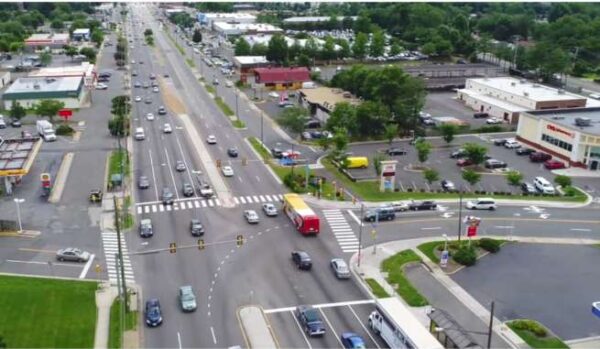
The clock is ticking for Fairfax County and the D.C. region to adopt a new transportation plan aimed at reducing greenhouse gas emissions.
This past June, the National Capital Region Transportation Planning Board (TPB) approved Visualize 2045 — a regional transportation plan that runs through 2045 and must be updated every four years, as mandated by the federal government.
At the same meeting, it voted to include greenhouse gas emission goals in the next plan, targeting cuts of 50% by 2030 and 80% by 2050.
Now, six months later, Fairfax County is already preparing to submit its segment of that plan with those emission goals in mind, but the process will be slightly different from previous years.
Presented at the Board of Supervisors transportation committee meeting on Tuesday (Jan. 31), Visualize 2050 will include “zero-based budgeting,” meaning all localities have to resubmit their transportation projects for consideration to ensure they adhere to the new emission reduction goals.
Before, most projects automatically carried over from one plan to the next, though projects could be added or taken out if needed, Fairfax County Department of Transportation planner Malcolm Watson explained to the supervisors.
Hunter Mill District Supervisor Walter Alcorn, who’s on the TPB with Braddock District Supervisor James Walkinshaw, noted that the board has had a “lively discussion” over the last few years regarding the emission goals.
“There’s been…quite a difference of opinion on the climate change stuff, particularly between the inner jurisdictions and the outer jurisdictions,” Alcorn said. “We are kind of right in between.”
County staff have identified 33 projects they expect to be part of the transportation plan and will need to be resubmitted under the new standards. Projects currently “in development” include Reston Parkway improvements, a new Dulles Airport Access road from Chain Bridge Road, and a widening of Frying Pan Road from Sully to Centreville roads.
Most of those projects are expected to be completed between 2025 and 2040.
There are 25 projects that could be exempted from the emission standards because they are already funded or under construction. Those include the Richmond Highway Bus Rapid Transit system, an I-495 overpass at Tysons Corner Center, and the $237 million Soapstone Connector.
Watson cautioned that the lists may change as projects get taken off and added, depending on priorities, the new emission goals, and other factors.
Next month, the TPB will issue a “call for projects,” and the lists will be officially published for public review.
“This will officially kick off Visualize 2050,” Watson said.
The county board ultimately will have to vote to approve the project lists over the summer before they get submitted to the TPB.
The hope is that by December 2024, the TPB will approve Visualize 2050, and the new emission goals will become the norm, making Visualize 2055 perhaps a bit less labor-intensive.
Photo via Fairfax County
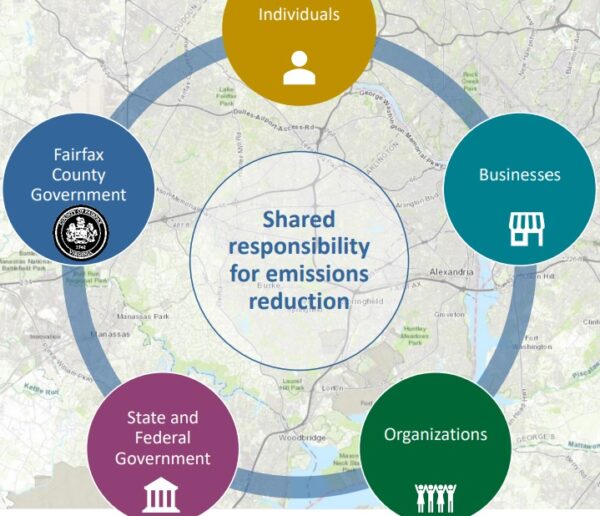
The clock is ticking on Fairfax County’s goal of achieving net-zero new carbon emissions by 2050.
With local government and school operations accounting for just 5% of all emissions, the county is developing a plan to help residents and organizations take action to reduce their carbon footprint and combat climate change.
Presented to the Fairfax County Board of Supervisors at an environmental committee meeting on Dec. 13, the proposal suggests starting to implement the Community-wide Energy and Climate Action Plan (CECAP) adopted in 2021 by partnering with businesses, nonprofits and others that will serve as “climate champions.”
“Every single person and organization can have negative or positive impacts for reducing our greenhouse gas emissions in time to prevent serious harm to our children, nature and communities,” Mount Vernon District Supervisor Dan Storck, chair of the environmental committee, said in a statement. “Each segment of our community…must have simple, easy, adoptable actions to get started and get done the changes we need.”
Expected to roll out early this year, the Climate Champions initiative will take a three-pronged approach, Office of Environmental and Energy Coordination (OEEC) staff told the board:
- A faith-based and nonprofit community pilot, led by the Faith Alliance for Climate Solutions (FACS)
- A business/industry pilot, focused initially on the hospitality sector and led by Visit Fairfax
- An outreach campaign aimed at getting individuals to reduce their greenhouse gas emissions
Having pilot projects focused on specific sectors will help the county tailor its resources, policies and messaging to their needs, Storck said.
A hotel owner, for instance, could provide insight into how their building could be more sustainable — and what incentives would make those changes feasible. Homeowners’ associations could raise awareness of programs like Solarize Fairfax County, which aims to reduce the cost of solar panel installations.
“We can sit in this room all we want, but we need messengers out there in the community, taking ownership of elements in CECAP to make sure we’re successful,” Board of Supervisors Chairman Jeff McKay said at the committee meeting.
Convincing churches and other places of worship to take action on climate change isn’t a challenge for FACS, a nonprofit with over 190 religious groups in Northern Virginia that has been a vocal advocate for CECAP and other environmental measures.
Many faith communities are already tackling climate projects, from solar sanctuaries that would turn them into refuges during power outages to staff at Reston’s St. John Neumann Catholic Church volunteering to clean up for events if they utilize reusable dishes and silverware to reduce waste.
The county’s pilot will help better coordinate those efforts and share ideas, while hopefully encouraging more congregations to get involved, FACS Executive Director Andrea McGimsey told FFXnow. Read More

With fall just around the corner, Fairfax County has begun to phase out gas-powered leaf blowers in favor of battery-powered blowers.
Last week, the county announced that its Park Authority and Department of Public Works and Environmental Services (DPWES) are “in the process of phasing out gas-powered blowers” in favor of “exclusively purchasing” battery-powered blowers.
“Having a gas-powered leaf blower operating in your vicinity is like inviting someone to blow a cloud of potentially dangerous chemicals, dust, and other pollutants in your direction,” the county website says. “A gas-powered leaf blower produces exhaust containing both hydrocarbons and nitrous oxides both of which are components of smog.”
The county is encouraging all contractors and residents to follow suit, saying battery-powered equipment is quieter, cleaner, and can be more cost-efficient to operate.
In November 2021, the Board of Supervisors overwhelmingly passed a board matter introduced by Braddock District Supervisor James Walkinshaw that called for a stop to the use of gas-powered leaf blowers.
In a statement to FFXnow, Walkinshaw said the county is “making good on that promise.”
Last year, the Board approved my motion to phase-out the use of gas-powered leaf blowers and lawn equipment on County-owned property. Now, I am pleased to say that we are making good on that promise by replacing the existing County inventory with electric blowers and incentivizing the use of electric equipment by our landscaping contractors.
Gas-powered leaf blowers can emit 23 times the carbon dioxide of a Ford F-150 and operate at noise levels that can cause hearing damage. This is about Fairfax County being a good neighbor to those living near our facilities and helping to accelerate a shift to electric landscaping equipment. I’m hopeful that incentivizing the use of electric equipment through our procurement process will encourage more local landscaping contractors to make that shift, giving residential and commercial property owners more choices in the marketplace.
Supervisors had hoped the county’s adoption of the ordinance would encourage the Virginia General Assembly to do the same. While other nearby localities have also taken up this issue in recent years, a recent House bill failed to get out of committee.
Fairfax County’s conversion may unfold gradually. Although the process started in December, there is no concrete timeline yet for when all the gas-powered blowers will be phased out, acting FCPA Public Information Officer Roberta Korzen told FFXnow.
“The gas-powered blowers will be phased out and replaced with battery-powered blowers at the end of their life cycle,” Korzen wrote in an email. A gas-powered leaf blower can last up to 10 years with proper maintenance.
The park authority currently has only seven battery-powered blowers, compared to more than 100 gas-powered ones. That number doesn’t include contractors.
It’s unknown how many gas-powered blowers are used by county contractors, but Korzen said the county “encourages the use of battery-powered blowers by its contractors.”
FCPA estimates it will cost about $150,000 to phase out the equipment.
“As funding and supply is available we are purchasing battery-powered blowers. We have made a few purchases to date. We are hoping additional funding will be available in the near future,” Korzen said.
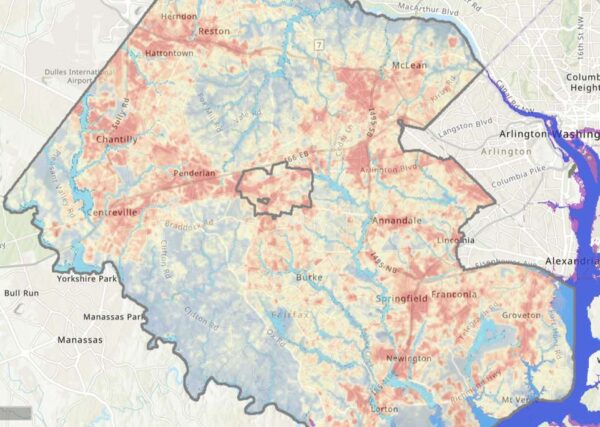
As Fairfax County finalizes its first-ever plan to address the future effects of climate change, community members can see how the phenomenon already affects them with a newly released interactive map.
Launched last week, the climate map depicts heat and flooding data that can be viewed in conjunction with maps of the county’s population and infrastructure, including roads, utilities, and public facilities.
“The Fairfax County interactive climate map is a dynamic tool showcasing some of the best available data we have to date on climate impacts in our community,” Matt Meyers, the climate planning division director for the Fairfax County Office of Environmental and Energy Coordination, said. “The map is meant to inform and empower county residents, business owners, and community leaders to actively prepare for and participate in resilience efforts on a local level.”
The map offers a clear illustration of the heat island effect, showing that average daytime temperatures are higher in more populated and developed areas along major highways, like Tysons, Reston, the Fair Lakes and Fair Oaks area, and the Route 1 corridor.
Flooding appears to be most intense in the southeast part of the county, with waters from the Potomac River and Occoquan Bay overflowing onto Belle Haven, Lorton, Mason Neck, and Fort Belvoir. If sea levels rise a foot, Mason Neck will noticeably shrink. If they rise three feet, the Route 1 ramps to I-495 at the Alexandria border will be submerged.
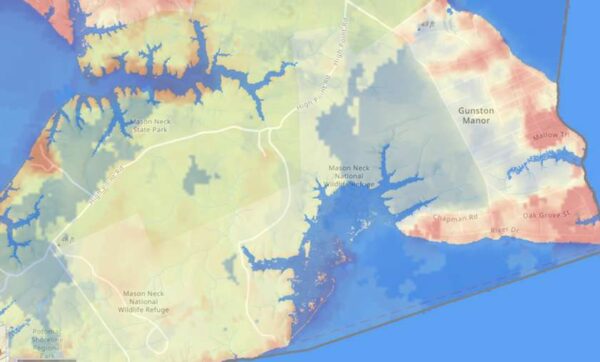
The OEEC developed the map using information gathered through its Resilient Fairfax initiative, which started last year to establish a Climate Adaptation and Resilience Plan intended to reduce and prepare the county for the damages that will come with a rapidly warming Earth.
So far, the initiative has produced:
- A Climate Projections Report, which found that rising greenhouse gas emissions could fuel a significant increase in days with temperatures over 95 degrees
- An audit analyzing how well the county’s existing policies and facilities take climate change into account
- A draft Climate Vulnerability and Risk Assessment, which looked at which residents, services, and facilities are most vulnerable to the impacts of climate change
- A draft Climate Adaptation and Resilience Plan that recommended creating a fund for climate-related county projects, among other proposals
The Climate Adaptation and Resilience Plan will be finalized and presented to the Board of Supervisors for acceptance this fall, according to OEEC spokesperson Ali Althen.
The climate map uses the same data that went into the projections report and risk assessment, but it’s narrower in scope, focusing on current flood and heat information with some indicators of future conditions, such as “projected sea level rise and coastal storm surge,” the OEEC says.
With marginalized communities facing the most severe consequences from climate change, the map also incorporates data from the county’s Vulnerability Index, which scored different areas based on residents’ income, education, homeownership, and other socioeconomic factors.
The OEEC says it’s important for residents to understand what climate hazards are in store for the county so they can get involved in efforts to address those impacts. In Belle Haven, for instance, the U.S. Army Corps of Engineers has already proposed building a wall to mitigate flooding.
“Awareness is the first step toward climate readiness, and we hope this tool will allow users to grow in their understanding of the risks facing Fairfax County now and in the years to come,” Meyers said.

